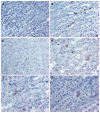Cancer stem cells in Helicobacter pylori infection and aging: Implications for gastric carcinogenesis
- PMID: 25133037
- PMCID: PMC4133534
- DOI: 10.4291/wjgp.v5.i3.366
Cancer stem cells in Helicobacter pylori infection and aging: Implications for gastric carcinogenesis
Abstract
Aim: To demonstrated the combined effects of aging and carcinogen treatment on cancer stem/stem-like cells (CSCs) of gastric mucosa in an animal model.
Methods: In this study we investigated the effects of aging and Helicobacter pylori (H. pylori) inflammation as a model for inflammation induced carcinogenesis in human and rat gastric mucosa samples. In aging studies, we compared 4-mo old (young) with 22 mo (aged) old Fischer-344 rats. For human studies, gastric biopsies and resection specimens representing normal mucosa or different stages of H. pylori gastritis and gastric adenocarcinomas were used for determining the expression of stem cell markers CD166, ALDH1 and LGR5. In addition we performed immunofluorescent double labeling for B-catenin and Lgr5 in both rat and human gastric tissues to examine the status of Wnt signaling in these cells.
Results: CSC markers ALDH1, LGR5, and CD166 were expressed in very low levels in normal human gastric mucosa or young rat gastric mucosa. In contrast, level of expression for all three markers significantly increased in H. pylori gastritis and gastric adenocarcinomas as well as in normal gastric mucosa in aged rats. We also observed cytoplasmic B-catenin staining in both aged rat and human H. pylori inflamed gastric mucosa, which were found to be colocalized with Lgr5 immunoreactive cells. The increased number of ALDH1, CD166 and LGR5 positive cells in H. pylori gastritis indicates that increased number of stem-like cells in gastric mucosa is an early event, and may constitute an important step in the progression to neoplasia.
Conclusion: Our observation of the age-related increase in cancer stem/stem-like cells in the gastric mucosa may explain the increased incidence of gastric cancer during aging. Combination of aging and H. pylori infection may have additive effects in progression to neoplasia.
Keywords: ALDH1; Aging; CD166; Cancer stem cells; Gastric cancer; Helicobacter pylori; LGR5.
Figures



Similar articles
-
Chronic CagA-positive Helicobacter pylori infection with MNNG stimulation synergistically induces mesenchymal and cancer stem cell-like properties in gastric mucosal epithelial cells.J Cell Biochem. 2019 Oct;120(10):17635-17649. doi: 10.1002/jcb.29031. Epub 2019 Jun 18. J Cell Biochem. 2019. PMID: 31209915
-
Helicobacter pylori infection-induced H3Ser10 phosphorylation in stepwise gastric carcinogenesis and its clinical implications.Helicobacter. 2018 Jun;23(3):e12486. doi: 10.1111/hel.12486. Epub 2018 Apr 15. Helicobacter. 2018. PMID: 29656498 Free PMC article.
-
Helicobacter pylori Activates and Expands Lgr5(+) Stem Cells Through Direct Colonization of the Gastric Glands.Gastroenterology. 2015 Jun;148(7):1392-404.e21. doi: 10.1053/j.gastro.2015.02.049. Epub 2015 Feb 26. Gastroenterology. 2015. PMID: 25725293
-
Apoptosis in gastric epithelium induced by Helicobacter pylori infection: implications in gastric carcinogenesis.Am J Gastroenterol. 2001 Jan;96(1):16-26. doi: 10.1111/j.1572-0241.2001.03447.x. Am J Gastroenterol. 2001. PMID: 11197247 Review.
-
Interplay between Helicobacter pylori and immune cells in immune pathogenesis of gastric inflammation and mucosal pathology.Cell Mol Immunol. 2010 Jul;7(4):255-9. doi: 10.1038/cmi.2010.2. Epub 2010 Mar 1. Cell Mol Immunol. 2010. PMID: 20190789 Free PMC article. Review.
Cited by
-
Role of Helicobacter pylori infection in the manifestation of old age-related diseases.Mol Genet Genomic Med. 2020 Apr;8(4):e1157. doi: 10.1002/mgg3.1157. Epub 2020 Feb 17. Mol Genet Genomic Med. 2020. PMID: 32067423 Free PMC article. Review.
-
Dormancy activation mechanism of tracheal stem cells.Oncotarget. 2016 Apr 26;7(17):23730-9. doi: 10.18632/oncotarget.8179. Oncotarget. 2016. PMID: 27009861 Free PMC article.
-
Impact of age on stage-specific mortality in patients with gastric cancer: A long-term prospective cohort study.PLoS One. 2019 Aug 1;14(8):e0220660. doi: 10.1371/journal.pone.0220660. eCollection 2019. PLoS One. 2019. PMID: 31369631 Free PMC article.
-
Aldehyde Dehydrogenase 1 in Gastric Cancer.J Oncol. 2022 Mar 9;2022:5734549. doi: 10.1155/2022/5734549. eCollection 2022. J Oncol. 2022. PMID: 35310914 Free PMC article. Review.
-
Expression of ALDH1A1 and CD133 is associated with the prognosis and effect of different chemotherapeutic regimens in gastric cancer.Oncol Lett. 2019 Nov;18(5):4573-4582. doi: 10.3892/ol.2019.10798. Epub 2019 Sep 4. Oncol Lett. 2019. PMID: 31611965 Free PMC article.
References
-
- Majumdar APN, Basson MD. Effect of Aging on the Gastrointestinal Tract. In: Physiology of the Gastrointestinal tract., editor. Johnson LR, Barrett K, Ghishan F, Merchant JI, Said HM, Wood JD, editors. New York: Academic Press; 2006. pp. 405–433.
-
- Barker N, Ridgway RA, van Es JH, van de Wetering M, Begthel H, van den Born M, Danenberg E, Clarke AR, Sansom OJ, Clevers H. Crypt stem cells as the cells-of-origin of intestinal cancer. Nature. 2009;457:608–611. - PubMed
-
- Boman BM, Huang E. Human colon cancer stem cells: a new paradigm in gastrointestinal oncology. J Clin Oncol. 2008;26:2828–2838. - PubMed
-
- Boman BM, Fields JZ, Cavanaugh KL, Guetter A, Runquist OA. How dysregulated colonic crypt dynamics cause stem cell overpopulation and initiate colon cancer. Cancer Res. 2008;68:3304–3313. - PubMed
Grants and funding
LinkOut - more resources
Full Text Sources
Other Literature Sources
Research Materials
Miscellaneous

